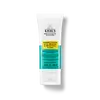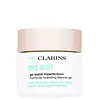What's inside
What's inside
 Key Ingredients
Key Ingredients

 Benefits
Benefits

 Concerns
Concerns

 Ingredients Side-by-side
Ingredients Side-by-side

Water
Skin ConditioningGlycerin
HumectantButylene Glycol
HumectantNiacinamide
SmoothingDimethicone
EmollientCetearyl Alcohol
EmollientIsohexadecane
EmollientSodium Hydroxide
BufferingAmmonium Polyacryloyldimethyl Taurate
Emulsion StabilisingLaureth-4
EmulsifyingPolyacrylate Crosspolymer-6
Emulsion StabilisingPropylene Glycol
HumectantDipotassium Glycyrrhizate
HumectantHydroxyethylcellulose
Emulsion StabilisingDimethiconol
EmollientTrisodium Ethylenediamine Disuccinate
Zinc PCA
HumectantGlyceryl Stearate
EmollientPEG-100 Stearate
Silica Silylate
EmollientHydroxypropyl Starch Phosphate
Maltodextrin
AbsorbentMenthol
MaskingLactobacillus Ferment
Skin ConditioningSalvia Officinalis Leaf Extract
CleansingChamomilla Recutita Flower Extract
MaskingSalicylic Acid 1.2%
MaskingWater, Glycerin, Butylene Glycol, Niacinamide, Dimethicone, Cetearyl Alcohol, Isohexadecane, Sodium Hydroxide, Ammonium Polyacryloyldimethyl Taurate, Laureth-4, Polyacrylate Crosspolymer-6, Propylene Glycol, Dipotassium Glycyrrhizate, Hydroxyethylcellulose, Dimethiconol, Trisodium Ethylenediamine Disuccinate, Zinc PCA, Glyceryl Stearate, PEG-100 Stearate, Silica Silylate, Hydroxypropyl Starch Phosphate, Maltodextrin, Menthol, Lactobacillus Ferment, Salvia Officinalis Leaf Extract, Chamomilla Recutita Flower Extract, Salicylic Acid 1.2%
Water
Skin ConditioningC9-12 Alkane
SolventButylene Glycol
HumectantGlycerin
HumectantPropylene Glycol
HumectantSilica
AbrasiveCocos Nucifera Fruit Juice
EmollientSodium Carbomer
Emulsion StabilisingSilica Silylate
EmollientAmmonium Acryloyldimethyltaurate/Vp Copolymer
Hydroxyacetophenone
AntioxidantParfum
MaskingTartaric Acid
BufferingHibiscus Sabdariffa Flower Extract
Skin ConditioningDisodium EDTA
Caprylic/Capric Triglyceride
MaskingTamarindus Indica Extract
SmoothingSodium Hydroxide
BufferingSpiraea Ulmaria Extract
AstringentMarrubium Vulgare Extract
Skin ConditioningLycium Barbarum Fruit Extract
AstringentCitric Acid
BufferingFicus Carica Fruit Extract
HumectantGentiana Lutea Extract
EmollientMalpighia Emarginata Seed Extract
Skin ConditioningPhenethyl Alcohol
MaskingFurcellaria Lumbricalis Extract
Skin ConditioningSodium Benzoate
MaskingRhododendron Ferrugineum Extract
MaskingArbutus Unedo Fruit Extract
AntioxidantPotassium Sorbate
PreservativeSorbic Acid
PreservativeLapsana Communis Flower/Leaf/Stem Extract
Skin ConditioningMaris Sal
Skin ConditioningCI 15985
Cosmetic ColorantCI 14700
Cosmetic ColorantWater, C9-12 Alkane, Butylene Glycol, Glycerin, Propylene Glycol, Silica, Cocos Nucifera Fruit Juice, Sodium Carbomer, Silica Silylate, Ammonium Acryloyldimethyltaurate/Vp Copolymer, Hydroxyacetophenone, Parfum, Tartaric Acid, Hibiscus Sabdariffa Flower Extract, Disodium EDTA, Caprylic/Capric Triglyceride, Tamarindus Indica Extract, Sodium Hydroxide, Spiraea Ulmaria Extract, Marrubium Vulgare Extract, Lycium Barbarum Fruit Extract, Citric Acid, Ficus Carica Fruit Extract, Gentiana Lutea Extract, Malpighia Emarginata Seed Extract, Phenethyl Alcohol, Furcellaria Lumbricalis Extract, Sodium Benzoate, Rhododendron Ferrugineum Extract, Arbutus Unedo Fruit Extract, Potassium Sorbate, Sorbic Acid, Lapsana Communis Flower/Leaf/Stem Extract, Maris Sal, CI 15985, CI 14700
 Reviews
Reviews

Ingredients Explained
These ingredients are found in both products.
Ingredients higher up in an ingredient list are typically present in a larger amount.
Butylene Glycol (or BG) is used within cosmetic products for a few different reasons:
Overall, Butylene Glycol is a safe and well-rounded ingredient that works well with other ingredients.
Though this ingredient works well with most skin types, some people with sensitive skin may experience a reaction such as allergic rashes, closed comedones, or itchiness.
Learn more about Butylene GlycolGlycerin is already naturally found in your skin. It helps moisturize and protect your skin.
A study from 2016 found glycerin to be more effective as a humectant than AHAs and hyaluronic acid.
As a humectant, it helps the skin stay hydrated by pulling moisture to your skin. The low molecular weight of glycerin allows it to pull moisture into the deeper layers of your skin.
Hydrated skin improves your skin barrier; Your skin barrier helps protect against irritants and bacteria.
Glycerin has also been found to have antimicrobial and antiviral properties. Due to these properties, glycerin is often used in wound and burn treatments.
In cosmetics, glycerin is usually derived from plants such as soybean or palm. However, it can also be sourced from animals, such as tallow or animal fat.
This ingredient is organic, colorless, odorless, and non-toxic.
Glycerin is the name for this ingredient in American English. British English uses Glycerol/Glycerine.
Learn more about GlycerinPropylene Glycol is an odorless, colorless liquid. As a humectant, it helps skin retain moisture. It also aids in delivering active ingredients.
Another role of this ingredient is preventing a product from melting or freezing. Propylene glycol also adds antimicrobrial properties to a product, elongating product lifespan.
This ingredient is considered an organic alcohol and commonly added into both cosmetics and foods.
Those with sensitive skin or conditions may develop a rash when using this ingredient.
Learn more about Propylene GlycolSilica Silylate is a siloxane polymer, meaning it is made up of silicon and oxygen atoms. It is not soluble in water.
This ingredient is a white powder with oil-absorbing, emollient, and anticaking properties.
Sodium Hydroxide is also known as lye or caustic soda. It is used to adjust the pH of products; many ingredients require a specific pH to be effective.
In small amounts, sodium hydroxide is considered safe to use. However, large amounts may cause chemical burns due to its high alkaline.
Your skin has a natural pH and acid mantle. This acid mantle helps prevent harmful bacteria from breaking through. The acid mantle also helps keep your skin hydrated.
"Alkaline" refers to a high pH level. A low pH level would be considered acidic.
Learn more about Sodium HydroxideWater. It's the most common cosmetic ingredient of all. You'll usually see it at the top of ingredient lists, meaning that it makes up the largest part of the product.
So why is it so popular? Water most often acts as a solvent - this means that it helps dissolve other ingredients into the formulation.
You'll also recognize water as that liquid we all need to stay alive. If you see this, drink a glass of water. Stay hydrated!
Learn more about Water